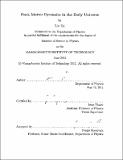Dark matter dynamics in the early universe
Author(s)
Fei, Lin, S.B. Massachusetts Institute of Technology
DownloadFull printable version (1.501Mb)
Other Contributors
Massachusetts Institute of Technology. Dept. of Physics.
Advisor
Jesse Thaler.
Terms of use
Metadata
Show full item recordAbstract
We study a new form of dark matter interaction which may significantly affect the thermal relic abundance of dark matter. This new interaction takes the form C+D --> C+[phi], where D is the dark matter species present today, [phi] is a standard model species, and C is a very heavy exotic particle. In particular, C was present during the period when freeze-out occurred for dark matter species D, but subsequently decayed into standard model particles. We refer to this process as a catalytic reaction, since C acts as a catalyst for the destruction of D. We further postulate that there is a matter-antimatter asymmetry in C, so that C+C --> D+[phi] is suppressed. We find that the catalytic reaction produces very different dynamics than the standard annihilation reaction. We also find that the catalytic reaction can significantly affect the relic abundance of dark matter even if it has a much smaller cross section than the annihilation reaction. Possible physical origins for this catalytic reaction are discussed.
Description
Thesis (S.B.)--Massachusetts Institute of Technology, Dept. of Physics, 2012. Cataloged from PDF version of thesis. Includes bibliographical references (p. 39).
Date issued
2012Department
Massachusetts Institute of Technology. Department of PhysicsPublisher
Massachusetts Institute of Technology
Keywords
Physics.